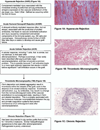Immunobiological barriers to xenotransplantation
- PMID: 26159291
- PMCID: PMC4684773
- DOI: 10.1016/j.ijsu.2015.06.068
Immunobiological barriers to xenotransplantation
Abstract
Binding of natural anti-pig antibodies in humans and nonhuman primates to carbohydrate antigens expressed on the transplanted pig organ, the most important of which is galactose-α1,3-galactose (Gal), activate the complement cascade, which results in destruction of the graft within minutes or hours, known as hyperacute rejection. Even if antibody is removed from the recipient's blood by plasmapheresis, recovery of antibody is associated with acute humoral xenograft rejection. If immunosuppressive therapy is inadequate, the development of high levels of T cell-dependent elicited anti-pig IgG similarly results in graft destruction, though classical acute cellular rejection is rarely seen. Vascular endothelial activation by low levels of anti-nonGal antibody, coupled with dysregulation of the coagulation-anticoagulation systems between pigs and primates, leads to a thrombotic microangiopathy in the graft that may be associated with a consumptive coagulopathy in the recipient. The most successful approach to overcoming these barriers is by genetically-engineering the pig to provide it with resistance to the human humoral and cellular immune responses and to correct the coagulation discrepancies between the two species. Organs and cells from pigs that (i) do not express the important Gal antigen, (ii) express a human complement-regulatory protein, and (iii) express a human coagulation-regulatory protein, when combined with an effective immunosuppressive regimen, have been associated with prolonged pig graft survival in nonhuman primates.
Keywords: Organ donation; Pig; Transplantation, islets; Transplantation, organs; Xenotransplantation.
Copyright © 2015 IJS Publishing Group Limited. Published by Elsevier Ltd. All rights reserved.
Conflict of interest statement
The authors declare no conflict of interest.
Figures
References
-
- Lexer G, Cooper DK, Rose AG, Wicomb WN, Rees J, Keraan M, et al. Hyperacute rejection in a discordant (pig to baboon) cardiac xenograft model. J Heart Transplant. 1986;5:411–418. - PubMed
-
- Cooper DK, Human PA, Lexer G, Rose AG, Rees J, Keraan M, et al. Effects of cyclosporine and antibody adsorption on pig cardiac xenograft survival in the baboon. J Heart Transplant. 1988;7:238–246. - PubMed
-
- Alexandre GPJ, Gianello P, Latinne D, Carlier M, Dewaele A, van Obbergh L, Hardy M. Xenograft. Vol. 25. Amsterdam, New York, Oxford: Excerpta Medica; 1989. Plasmapheresis and splenectomy in experimental renal xenotransplantation; pp. 259–266.
-
- Rose AG, Cooper DK, Human PA, Reichenspurner H, Reichart B. Histopathology of hyperacute rejection of the heart: experimental and clinical observations in allografts and xenografts. J Heart Lung Transplant. 1991;10:223–234. - PubMed
-
- Rose AG, Cooper DK. Venular thrombosis is the key event in the pathogenesis of antibody-mediated cardiac rejection. Xenotransplantation. 2000;7:31–41. - PubMed
Publication types
MeSH terms
Substances
Grants and funding
LinkOut - more resources
Full Text Sources
Other Literature Sources


